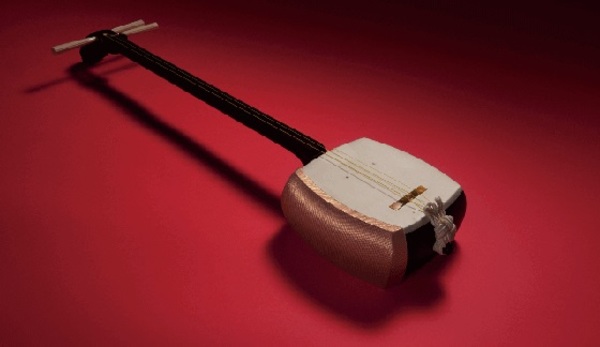
- Other crafts
- Tokyo
Tokyo Shamisen Tokyo Shamisen
Having a strong commitment to make a one-and-only instrument for one musician
Beautiful music created by the musician and the artisan
Description
What is Tokyo Shamisen ?
The Tokyo Shamisen is made from the beginning to the end by one artisan. In the Kansai area, the work is divided among a number of artisans, but the Tokyo Shamisen is custom made for the musician by one artisan. It is a craft made by the artisan and musician's teamwork. As the sound quality differs depending on the difference of the size of the pores and thickness of the leather, the musician's skills and capabilities need to be considered from the very beginning of choosing the material. The shamisen is made to create the ideal sounds for the musician.
Tokyo Shamisen is also a Japanese instrument that can be used for a long time with the care and repair of the experienced and skilled artisan. The number of artisans are gradually decreasing with the depletion of the material traditionally used for shamisen, and machine-made shamisen increasing. However, it is being produced mainly in the Chuo ward, Taito ward, Toshima ward etc. of Tokyo. In recent years there are approaches to repair and renovate old shamisens and sell them to beginner musicians at a low price.
History
The origin of the shamisen is said to be the Chinese three-stringed instrument, sanxian. It was introduced to the Ryukyu Kingdom (current Okinawa) at the end of the 14th century and became the sanshin. This was brought to Sakai, Osaka at the end of the Muromachi period (1336 - 1573), and is said to be the beginning of shamisen. As they used snake skin for sanshin in the Ryukyu Kingdom, the instrument was also called jabisen (jabi meaning snake skin), but as it was difficult to acquire snake skin on the main island of Japan, and to enhance the strength, dog or cat skin was used instead. Afterwards, this became the shamisen that was played with a plectrum. When this came to Edo in the 17th century, it developed independently from the original style, and Edo (Tokyo) became a production area for shamisen. Master artisans of the shamisen such as Harumitsu Kanda emerged, and with the influence of these artisans, the base of shamisen music that we know today was established. Shamisen music spread among the public, and since the Edo period, the shamisen has become a representative instrument for Japanese music. As nagauta (epic Kabuki songs), gidayu (puppet theater recitations), tokiwatsu (a kabuki narrative), kiyomotobushi and shinnaibushi (narrative pieces) became popular, the manufacturing of shamisen also flourished. The Tokyo Shamisen is a Japanese instruments played widely even today, from professional musicians to students.
General Production Process
- 1. Cutting the wood The wood is cut for the tenjin (head), sao (neck) and body.
- 2.Making the head and neck The wood for the neck is cut into three pieces and are assembled by making tenons and grooves with a chisel. Grooves called sawarimizo are carved on the head.
- 3. Attaching the body After the 4 pieces of wood that are to be the body undergo carving of ayasugi (zigzag pattern carving on the backside), they are glued together with animal glue.
- 4. Stretching over the leather The moistened leather is stretched over the body frame using wooden clips called kisen to hold the leather, and the leather is stretched with ropes from all four sides.
- 5. Assembling all of the parts, adjusting and finishing The neck is attached to the body, the strings, bridge and dokake (slip guard) are attached, and the shamisen is complete.
See more Other crafts
- Edo kiriko cut glass
- Koshu lacquered deer leather
- Kyo folding fans
- Marugame uchiwa fans
- Boshu uchiwa fans
- Gifu lanterns
- Yamaga lanterns
- Kyo uchiwa fans
- Tendo Japanese chess pieces
- Edo glass
- Edo patterned paper
- Yame lanterns
- Owari Cloisonné
- Fukuyama Koto (Japanese Harp)
- Kyo art preservation
- Banshu fly-fishing flies
- Woodblock prints
- Koshu hand-carved seals
- Edo Hyogu (Art Mountings)
- Edo tortoise shell crafts
- Etchu Fukuoka Sedge Hats
- Gifu Japanese Umbrellas
- Nagasaki tortoise shell crafts
- Nagoya Sekku Kazari
- Sanshin
- Tokyo Koto (Japanese Harp)
- Tokyo Shamisen
See items made in Tokyo
- Edo kiriko cut glass
- Edo wood joinery
- Edo glass
- Murayama-oshima tsumugi silk
- Tokyo silverware
- Edo patterned paper
- Tokyo fine-patterned dyeing
- Edo bamboo fishing rods
- Tama brocade
- Hachio island silk
- Woodblock prints
- Tokyo textiles
- Edo-sekku doll
- Edo Hyogu (Art Mountings)
- Edo Oshi-e Pictures on Embossed Fabric
- Edo tortoise shell crafts
- Tokyo Honzome Chusen
- Tokyo Koto (Japanese Harp)
- Tokyo Plain Dyeing
- Tokyo Shamisen
- Tokyo antimony craft































































































































































































































































































